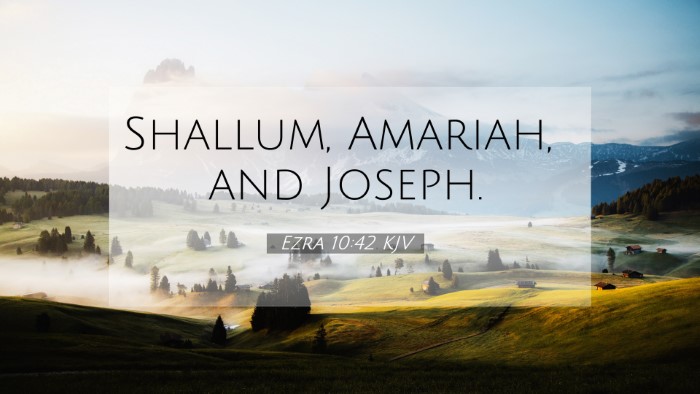Understanding Ezra 10:42
Ezra 10:42 reads, "And of the sons of Eliashib, Mattaniah and Zechariah, and of the sons of Pahath-moab, Adijah, and the sons of Elam, Jaazaniah, and of the sons of Zattu, Eliashib."
This verse presents a list of individuals who played a significant role during the return of the exiles from Babylon to Jerusalem. In context, Ezra was leading a reform that aimed to restore the worship practices and purity of the community according to the Law of Moses.
Commentary Insights
-
Matthew Henry: Emphasizes the importance of the names listed, illustrating the faithfulness of families in preserving their lineage and their roles in the restoration of Israel. The names signify not just individuals but also the continuation of heritage and commitment to God's covenant.
-
Albert Barnes: Points out the exact lineage of each individual mentioned reflects a meticulous attention to record-keeping and the significance of priestly lineage in the Jewish faith. This reflects on the seriousness of the reforms taking place in Jerusalem.
-
Adam Clarke: Highlights that the individuals named were likely instrumental in the leadership and spiritual direction of the community post-exile. Names can represent identity, and in a covenant community, this identity is linked to their relationship with God and the temple practices.
Thematic Connections
Ezra 10:42 connects to several themes within Scripture, including:
-
Covenant Faithfulness: This aligns with themes found in Genesis 17:7 and Deuteronomy 7:9, where God speaks of covenant loyalty and faithfulness to the generations.
-
Restoration of Worship: The reforms undertaken in Ezra draw parallels to Nehemiah 8:1-12, where the reading of the Law leads to a restoration of proper worship and community order.
-
Importance of Lineage: The genealogical records present in Matthew 1:1-17 showcases the significance of lineage, especially towards understanding Jesus’ earthly ministry and its roots in Jewish tradition.
-
The Role of Remnant: This reflects the broader biblical concept of a faithful remnant seen in Isaiah 10:20-22 and Romans 11:5, suggesting that even in times of scattering, God preserves a group faithful to Him.
-
Community Restoration: Ezra’s efforts resonate with Acts 2:44-47, which discusses the formation of the early church community and the focus on collective faith and communion.
-
Obedience to God’s Law: The act of returning and aligning to God's commandments is emphasized throughout the Psalms, particularly in Psalm 119:1, which speaks of the blessings for those whose walk is blameless.
Cross-Referencing Biblical Texts
In studying Ezra 10:42, one should consider several cross-references that enrich the understanding of the text:
-
Nehemiah 12:1-9: Details the list of priests and Levites, and connects with the idea of community roles and responsibilities in worship.
-
1 Chronicles 3:19: Offers insight into the lineage of the high priests, demonstrating continuity in priestly duties throughout generations.
-
Ezra 2:3-35: The initial list of returnees that identifies the importance of family and tribal affiliations in returning to the covenant.
-
Malachi 2:4-7: Speaks to the role of priests and their duty to teach and preserve the covenant, reflecting the responsibility those named in Ezra had toward the community.
-
Hebrews 7:14: Connects the priesthood of Jesus with the Levitical priesthood demonstrating the significance of priestly lineage and roles.
-
Isaiah 61:4: Promises restoration and rebuilding, which relates to the physical and spiritual renewal sought during Ezra's leadership.
-
Luke 3:23-38: Lists the lineage of Jesus, tying back into the importance of genealogical records that affirm God's work through various generations.
Practical Applications
Understanding Ezra 10:42 encourages believers to reflect on their own lineage of faith, the importance of community in spiritual practice, and the commitment to God’s covenant today. Linking these biblical themes through cross-referencing encourages deeper study and engagement with Scripture, enhancing personal faith journeys and community worship.
For further exploration of connections between Bible verses, consider tools for cross-referencing, such as a Bible concordance or various Bible reference resources. Engaging with scripture through a cross-reference Bible study can illuminate themes and cultivate a richer understanding of faith and practice within both individual and communal contexts.
Conclusion
Ezra 10:42 serves as a reminder of the foundational aspects of faithfulness and community that are crucial to understanding both the Old Testament teachings and their New Testament fulfillment in Christ. Studying these connections allows believers to appreciate the continuity of God’s work throughout Scripture and their own lives.


